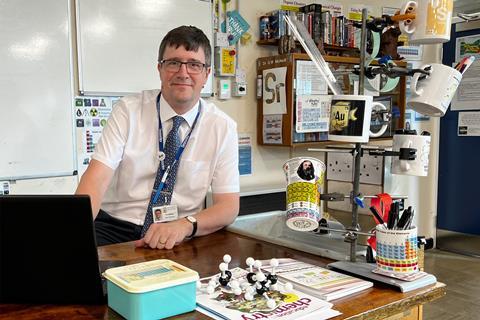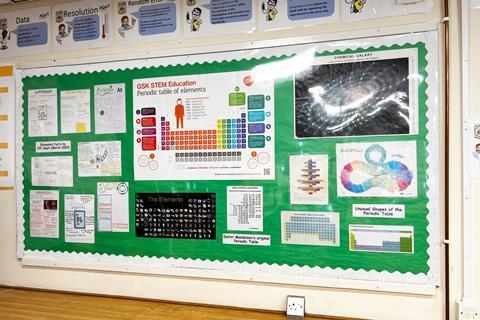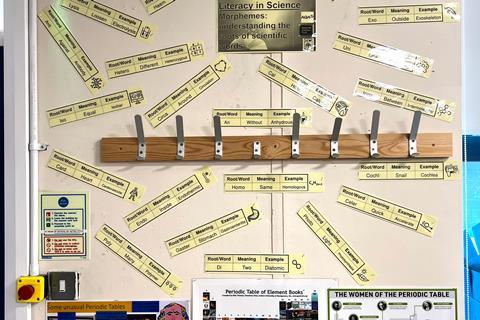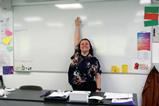Where he periodically adds to his bountiful displays, and wonders if he’s broken a world record

Meet Gavin McNeill, who’s been teaching for 20 years and previously worked in hydrogeochemistry. He’s currently head of chemistry at Tarporley High School and Sixth Form College – a large, comprehensive school in the heart of rural Cheshire – with students from a wide range of family backgrounds. Gavin teaches year groups 7 to 13, and he’s always taught AQA: both at GCSE (Separate Sciences and Combined Trilogy) and A-level chemistry.
Tell us about your school
The school is part of a multi-academy trust (MAT) called the Sandstone Trust, with just over 1000 pupils in the main school and up to 200 in the sixth form. The school was built in 1958, and then extended in the 1970s to include the block where my lab is based. We also have some Portakabin-style classrooms, which will hopefully soon be replaced with 15 teaching rooms, and a separate sixth form centre.
What’s your classroom set-up like?
It’s very traditional in its set-up as it has big, old science benches in three rows so all students are facing the TV screen where I show PowerPoint slides, YouTube clips and so on. When I use the whiteboard, students sometimes have to move to see what I am writing as this faces another direction. Another issue is that there are no gas taps and sinks in the middle of the room, so students have to stand at the benches along the front and back walls when working with Bunsen burners. It’s quite tricky to keep an eye on them all to ensure they are working safely.
Show us your classroom and lab
Want to share your teaching space? Then email us and your favourite space or display could feature in EiC online and in print.
What are you most proud of in your lab?
I am known at school as being obsessed with the periodic table, as my lab has over 50 copies of it on the walls (as well as housing the usual chemistry teacher’s supply of periodic table mugs, water bottle, mouse mat, lunch box, shower curtain, etc). I don’t know if there’s a world record for this, but it’s something that staff associate me with and shows students how passionate I am about chemistry.
A lot of the periodic tables display the elements in traditional symbol or picture format, but I’ve created most of them myself. I take a theme – sports stars, flags, children’s TV characters, for example – and then I think of an example for each of the 118 elements, with the letters of the element’s symbol in its name.
My favourite wall display contains 24 periodic tables, based on the subjects students study at Tarporley High. For example, there’s a periodic table of battles for history, another containing company logos for business studies, and one with colours for art. I’ve created so many that I now display a periodic table of the week, which changes ‘periodically’, just like our school word of the week.
I recently published a children’s picture book, Periodic table people, where all 118 elements of the periodic table come alive, have an alliterative name and perform an alliterative task, eg ‘Mandy Manganese manages mangoes’ or ‘Billy Bismuth builds bins’. It’s for KS2 pupils, so when I visit local primary schools, I get them to invent and draw their own characters. I have some examples on my lab wall.
With an unlimited budget, what would you add to your lab?

I’d simply get rid of the old benches and redesign the lab, perhaps with some central sink/gas tap working areas where the water/gas supply drops down from the ceiling. I’d also move the large whiteboard next to the TV screen, to replace the small whiteboard.
What do you love about your lab?
I’m very proud of my ‘chem-mug-tree’, which I recently made from a clamp stand, clamps and bosses, and is g-clamped on to the bench where I sit in the mornings prepping for the day. The mug tree displays my many chemistry-themed mugs gifted by students, and it’s a stationary holder – useful for students who forget their pens.
Any closing thoughts?
I think it’s important to make your teaching space as interesting as possible for students, and to show them how passionate you are about your subject. Obviously, a lot of schools share teaching spaces so the personal aspect is not always possible, but I think every science lab should inspire students to learn more about the subject and possible future scientific careers. And if anyone wants to make their own periodic table, they can contact me at gmcneill@tarporleyhigh.co.uk for a copy of the Excel file I use to create them.
Also have an impressive collection of periodic tables in your classroom? Then why not share your pics on Twitter …

















No comments yet